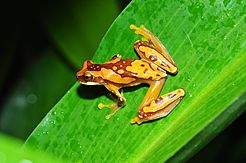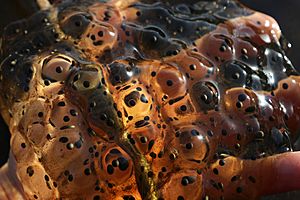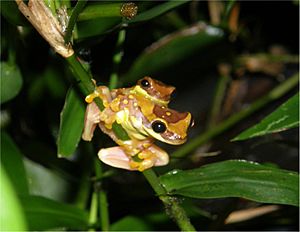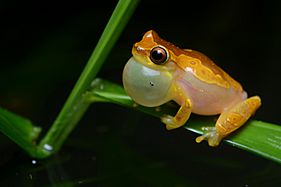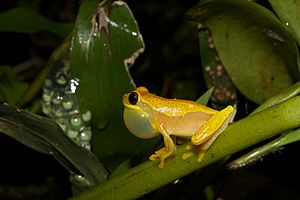Hourglass treefrog facts for kids
Quick facts for kids Hourglass treefrog |
|
|---|---|
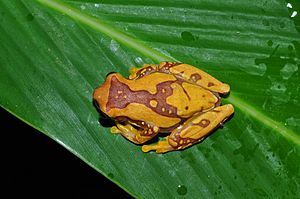 |
|
| with hourglass back | |
| Conservation status | |
| Scientific classification | |
 |
|
| Range in Mexico: central Mexico (red), southern Pacific coast (blue) & Yucatan Peninsula (green) | |
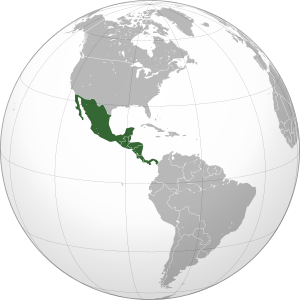 |
|
| Mexico and central america regions of D. ebraccatus range | |
| Synonyms | |
|
Hyla weyerae Taylor, 1954 |
The Dendropsophus ebraccatus, also known as the hourglass treefrog, is a small frog with a cool golden-brown hourglass shape on its back. This pattern is surrounded by bright yellow skin. Their bellies are also yellow. Their arms and lower legs often have bold patterns, but their upper legs (thighs) are light yellow. This makes them look like they aren't wearing any pants! In fact, their species name "ebraccata" means "without trousers" in Latin.
These frogs live in many parts of Mexico, including southern Veracruz and the Yucatán Peninsula. You can also find them further south in Central America, like Guatemala, Belize, Costa Rica, and Panama. They are less common in Honduras and Nicaragua, but they are often seen in northern Colombia and northwestern Ecuador.
Contents
What Kind of Frog Is It?
The hourglass treefrog, Dendropsophus ebraccatus, belongs to a large family of tree frogs called Hylidae. It is part of the Dendropsophus group. This group includes many small, mostly yellow tree frogs found across Central and South America. A special fact about all frogs in the Dendropsophus group is that they each have 30 chromosomes.
In 2005, scientists made some big changes to the Hylidae family. That's when D. ebraccatus moved from the Hyla group to the Dendropsophus group. You can tell an hourglass treefrog apart from similar frogs by its unique hourglass pattern on its back. This helps to tell it apart from close relatives like D. manonergra and D. triangulum.
How to Spot an Hourglass Treefrog
Hourglass treefrogs are small and have smooth skin. Male frogs are much smaller than females. Their back can be yellow, gold, or brown with blotches and spots. These blotches often form the famous hourglass shape, with bright yellow skin around it.
They are called "pantless frogs" because their thighs are pale yellow, without the darker patterns seen on the rest of their legs. This makes it look like they are not wearing pants when their hind legs are stretched out. Hourglass treefrogs have big front limbs for their body size. They also have well-developed toe pads that help them stick to trees. These pads work by changing shape, allowing them to grip surfaces. Their long back legs are great for jumping between trees. Unlike most frogs, they breathe mostly through their nostrils. However, they release most of their carbon dioxide through their permeable (absorbent) skin.
Where Hourglass Treefrogs Live
The hourglass treefrog is native to Mexico. You can find them in southern Veracruz, northern Oaxaca, Chiapas, Tabasco, and the Yucatán Peninsula. They are also commonly seen in countries further south, like Guatemala, Belize, Costa Rica, and Panama. There are only a few known groups of D. ebraccatus in Nicaragua and Honduras. They are also found more often in northern Colombia and northwestern Ecuador.
Reproduction and Life Cycle
Hourglass treefrogs move to freshwater pools in areas with lots of plants to breed. This happens during the rainy seasons in Central and South America, from May to November. When they gather around these pools, males use loud calls to attract female mates. Males hide behind leaves near marshes and ponds at night. They make long mating calls to find females.
Female frogs can lay eggs many times during the breeding season, sometimes as often as every 10 days. A female can lay between 180 and 300 eggs in one night. These eggs are laid in up to eight different groups. They can lay eggs in two ways:
- In a single layer on the top of leaves hanging over freshwater.
- In clusters attached to plants floating in the water.
Hourglass treefrogs are special because they can lay eggs both on land (arboreal) and in water (aquatic). Eggs laid on leaves over water allow the tadpoles to roll into the water once they hatch. Aquatic eggs are attached to floating plants to keep them from sinking.
Mating Calls and Behavior
Male frogs often call together in groups to attract females. How well a male frog attracts females depends on how clearly his call can lead females to him. When many males are calling, their calls can get mixed up. This makes it hard for females to find the right male.
Males have a "tolerance level" for how loud a neighbor's call can be. If a neighbor's call is too loud, the male frog will use a different call, called an "aggressive call." This call is used to show other males that they are too close. Both normal calls and aggressive calls start with a note and end with a series of clicks. Aggressive calls are usually repeated more often and last longer than normal calls.
Unlike most frogs, hourglass treefrogs often use aggressive calls even when other males are far away. This means they are influenced by many calls around them, not just those from close neighbors. This makes them constantly adjust their calls. Males will usually match calls that are 2–4 Hz with their own normal calls. But if a call is 100 dB or louder, they might use alternating calls or a delayed aggressive call.
For aggressive calls, long calls are used for close interactions and physical fights. These fights usually last about a minute. Short calls are used for interactions with frogs that are further away.
Choosing a Mate
The timing of a male's call is very important for female D. ebraccatus when choosing a mate. If males call at the same time, the male who starts his call later often has more success. Females seem to prefer calls that end last. The clicking sounds at the end of the late call might be why females like them, as the clicks from the first call are often covered up.
Male D. ebraccatus frogs tend to make their normal calls at the same time as others. But they prefer to alternate with other calls when they make aggressive calls. Calls with an introductory note lasting 150 to 200 milliseconds get the best synchronized responses. Even though females generally prefer the late call, they are most attracted to a late call that follows the usual timing of a normal advertising call. If the first male switches to an aggressive call, the increased overlap with the late advertising call can make females less interested.
The number of notes in a male's call also affects mate choice. Often, a responding normal call will have many notes. However, in very crowded groups, normal calls might only have one note.
Courting Behavior
Male D. ebraccatus frogs make calls to attract and court females for mating. There are two types of timed calls: "lead calls" (which start first) and "late" or "lagging calls" (which start in the middle of the lead call). The timing of late-calling males forces their rivals to finish calling in the middle of their own call. This means the late caller finishes his call while his rival's call is still being heard.
To deal with late callers, leading males have developed a strategy: they switch to aggressive calls. Since aggressive calls are longer than normal calls, the lead male can finish last more often. This helps them have more reproductive success. This strategy helps explain why D. ebraccatus frogs have so many aggressive calls, which would be costly for other types of chorus frogs.
However, late-calling males cannot just delay their calls longer to avoid overlap. The time it takes for one male to respond to another's call is usually around 210 milliseconds. The only time this changes is when males switch to aggressive calling. There's also evidence that males sometimes make mistakes in detecting aggressive calls. This can lead to slower responses to threats and less attraction from females because the call timing is off. Since females prefer less aggressive and normal calls, this might explain why males try to match their aggression levels to other calls, rather than just increasing their aggression.
A synchronized call with many notes has two benefits:
- Multiple notes can hide the clicks in the leading call.
- Synchronizing reduces the chance of the leader responding with another call. Many frogs won't answer if a call is made less than 210 milliseconds after their first call began.
The only time a synchronized normal call is not multi-noted is in very dense groups, where normal calls are only one-noted.
What Hourglass Treefrogs Eat
When they are tadpoles, hourglass treefrogs are herbivores, meaning they eat plants. However, they might eat dead tadpoles if they are around. Adult D. ebraccatus mainly eat Lepidoptera (butterflies and moths), Diptera larva (fly larvae), and Araneae (spiders). They eat these prey when they are common in the area. Hourglass treefrogs eat the same things as D. phlebodes, but D. ebraccatus tends to eat larger prey.
Parental Care: Laying Eggs
Eggs laid in water develop a little faster than eggs laid on leaves. They usually hatch in about 3.5 days. However, both types of eggs can change their development speed if conditions are bad, like bad weather or if predators are nearby. They can hatch 67% faster or 600% slower than normal. The speed of development is partly controlled by special enzymes released by a gland inside the egg. These enzymes break down the egg's jelly-like membrane.
D. ebraccatus frogs are special because they can lay their eggs in many places. Unlike most vertebrates (animals with backbones), these frogs can lay eggs both in water and on land. Most vertebrates have adapted to lay eggs only in one environment. Scientists think D. ebraccatus is still developing adaptations for both air and water. They choose where to lay eggs based on:
- The risk of the eggs drying out (Desiccation).
- Where predators are located.
- How deep the water is.
During drier seasons, D. ebraccatus eggs dry out much faster on land than other amphibian eggs. However, D. ebraccatus embryos can survive better in water than other land-based amphibian embryos, which often die before hatching. In places with little shade, female D. ebraccatus are more likely to lay their eggs underwater. They might also lay eggs on floating plants to hide them from predators. If land plants flood, the eggs become exposed to predators they were previously hidden from. When deciding to lay eggs underwater in dry seasons, females must consider the water's depth. If it's too deep, the eggs don't get enough oxygen and die. The danger from water predators is often a bigger concern than the risk of drying out.
The small size of D. ebraccatus eggs (about 1.2-1.4 mm in diameter) helps them. This small size means they need less oxygen and can absorb oxygen better underwater. This ability to lay eggs in different places shows that D. ebraccatus is in an interesting stage of evolution for how frogs reproduce.
Tadpole Journey
Once eggs hatch, tadpoles either appear in the water or roll off leaves into the pond below. Tadpoles are brown and gold with black bands around their eyes. They develop bright red tails if predators are nearby. Tadpoles eat tiny creatures and scavenge in the water until they grow up, which takes about 6–8 weeks. Young frogs stay near water pools and only move into the forest canopy when they are almost adults.
Social Behavior
Male aggressive calling is not just about mating or defending their space. It's also affected by how many other aggressive males are around. The social environment influences how strong a male's aggressive calls are when another frog tries to enter his space.
Aggressive calls between males are not always just from one frog to another. Often, one call can be heard by many frogs. All these frogs then compete to make a responding call that the original frog will hear. This means D. ebraccatus males compete in many ways during chorusing (group calling). They compete for the best territory to make calls that are heard over others. They also compete for space where they can hear calls themselves. They can also adjust how loud their own aggressive calls are based on the calls around them. Males make their calls more aggressive when there are more competitors or when the calls around them are more aggressive. They make their calls less aggressive when there are fewer competitors or when the surrounding calls are less aggressive.
Living in Groups
Most male chorus frogs start the night with high levels of aggressive calls. Then, they settle into a "stable chorus" with few or no aggressive calls. This happens because they get used to (habituate to) repeated calls that are louder than their usual limit. However, a large number of D. ebraccatus males keep making aggressive calls throughout the night, with only a small decrease. This means D. ebraccatus males don't get used to aggressive calls. Instead, they become more sensitive to them. They actually lower their aggressive limit after hearing repeated loud calls. This leads to more frequent aggressive calls than in other chorus frogs.
Frogs that call in groups use aggressive calls to defend their territory from other males. For a while, scientists didn't know why hourglass treefrogs kept up such high calling rates, which could put them in danger.
One reason for high aggressive calling levels might be that D. ebraccatus initially has the same limit for aggressive and normal calls. They need to lower their aggressive limit to tell the difference between these two types of calls. Usually, males take about 210 milliseconds to respond to a call with their own. The only time this changes is when they decide to switch to aggressive calls. Males seem to respond more slowly with their first aggressive call because they are trying to figure out if the other call was normal or aggressive. Another reason for more aggressive calls is that lead males use aggressive calls as a strategy to become more attractive to females.
Another unique thing about D. ebraccatus males is that their aggressive calls are often meant for frogs far away. These frequent long-distance aggressive calls in large groups mean that D. ebraccatus males are influenced by many calls around them, not just individual frogs. This influence from other males, rather than just attracting females, forces these male frogs to constantly adjust their calls.
Protective Colors
Tadpoles that develop a special look to protect them from predators often have the largest, deepest, and reddest tail fins. But this comes at a cost: they grow to be the smallest overall size. This happens when D. ebraccatus tadpoles grow up near the Pantala flavescens, also known as the dragonfly nymph. Dragonfly nymphs are smaller, can swim into tight spaces, and usually hunt alone. The tadpoles develop in a way that helps them escape an attack and usually survive.
Tadpoles develop a different look when they meet another type of predator, the Astyanax ruberrimus fish. When D. ebraccatus tadpoles grow up near these fish, they develop shallow, plain-colored tails. This is because Astyanax ruberrimus are fast fish that can eat prey larger than themselves by attacking repeatedly and then swallowing them whole. These fish also usually hunt in groups, and individual tadpoles can be attacked many times by several fish. The tadpoles grow smaller to try and avoid these attacks more easily.
Conservation Status
The IUCN Red List of Threatened Species listed the Hourglass Tree Frog as a species of "least concern" (LC) in 2010. This is because they are found in many places, their population is stable and large, and they can adapt well to changes in their habitat. Even though they are very adaptable, they still face threats. These include:
- deforestation (cutting down forests)
- agriculture (farming and ranching)
- logging (cutting down trees for wood)
- building homes and businesses
- the pet industry
- pollution
Research on Hourglass Treefrogs
The skin of frogs in the Hylidae family is studied a lot because it contains many useful peptides. These are small proteins that have sparked interest for drug development. Frogs in the Hylidae family use these peptides to defend themselves against bacteria, fungi, protozoans, viruses, and drying out.
Scientists are interested in these peptides because they have potential for fighting infections and for medical treatments. Peptides have been found to help release insulin, which could be useful for treating Type 2 diabetes. They are also used as building blocks for creating cDNAs. Since harmful bacteria and fungi are becoming resistant to antibiotics, scientists are looking to frog skin secretions for new drug discoveries.
See also
 In Spanish: Rana arbórea amarillenta para niños
In Spanish: Rana arbórea amarillenta para niños



